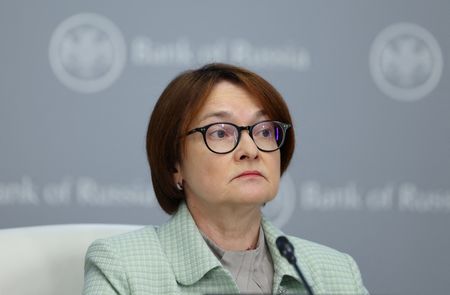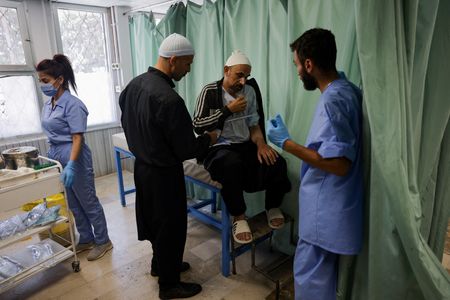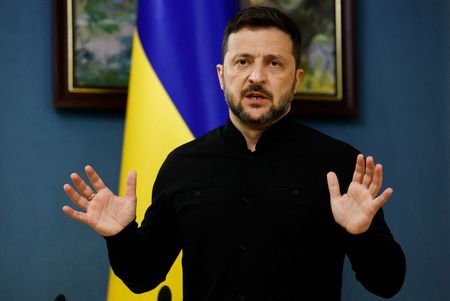MOSCOW (Reuters) – Russian Central Bank Governor Elvira Nabiullina and her deputy Alexei Zabotkin addressed a news conference on Friday after the central bank cut its key rate to 18% from 20%.
They spoke in Russian and the quotes below were translated into English by Reuters.
NABIULLINA ON KEY RATE DECISION:
“During the discussion, options for reducing the rate were considered, the option of maintaining the rate was not considered. Options for reducing the rate by 100, 150 and 200 (basis points) were considered, but the options of 100 and 200 (basis points) were discussed in detail.”
NABIULLINA ON FUTURE RATE DECISIONS:
“If you look at our forecast for the key rate, it suggests that by the end of the year, at individual meetings, reductions of 100, 150 and 200 basis points are possible, as well as pauses. Here everything will depend on the incoming data. But such a uniform trajectory of reduction may be possible with a more convincing picture of inflation stabilisation, inflation expectations at a low level and the absence of new inflation shocks. For now, we assume the possibility of various steps.”
“We are on the path to returning inflation to target, but this path has not yet been completed. There are already initial results. They allowed us to reduce the key rate again today, smoothly adapting the degree of monetary policy tightness to reduce inflationary pressure.”
“But returning to the target does not simply mean several months of current price growth near 4%. It implies a stable consolidation of inflation at a low level not only in actual data, but also in the perception of people and businesses.”
“Monetary policy has ensured a downward reversal of inflation, and it must remain tight for as long as it takes to sustainably return inflation to 4% in 2026 and consolidate it near this level.”
NABIULLINA ON BANK RECAPITALISATION AND BAD DEBTS:
“We do not see any need for recapitalisation of large banks due to the potential overhang of bad debts. The banking sector is profitable.”
*NABIULLINA ON RUMOURS OF POSSIBLE BANKING CRISIS, SUPPORT MEASURES IN SUCH A SCENARIO
“I will say again that these are rumours that are not based on anything … I can also give figures, because you need to look at the figures and the financial indicators. The banks are stable, they earn money, they have capital reserves. All this allows them to feel quite confident.”
“We are keeping our finger on the pulse, but I do not see any reason to consider state support (for banks) in one form or another.”
NABIULLINA ON INFLATION RISKS:
“In the aggregate, pro-inflationary risks continue to prevail. However, when making decisions, we also take into account disinflationary risks. The main one is a faster cooling of credit and demand than we expect in the baseline forecast.”
“We will reduce the rate in such a way that a spike of inflation does not occur. But, of course, we are concerned about increased inflation expectations.”
ZABOTKIN ON INFLATION RISKS:
“The indications of caution in further decisions on the rate, which were voiced in the chairman’s statement, are essentially a reference, among other things, to the fact that we, of course, will act with an eye on what is happening with inflation expectations. It cannot be otherwise”
NABIULLINA ON BUDGET:
“Budget policy remains an important input for our forecast. We assume that the budget rule will be followed this year and in the following years. If budget plans change, it may be necessary to adjust the key rate trajectory.”
NABIULLINA ON ECONOMIC CONDITIONS:
“Compared to April, we have lowered our forecast for Russian oil prices to $55 per barrel this year and next. We have also slightly lowered our forecast for exports and the current account of the balance of payments for the next two years.”
“At the same time, the rouble exchange rate is affected by flows not only on the current account, but also on the financial account of the balance of payments. High interest rates support the attractiveness of rouble assets compared to foreign ones for Russian citizens and companies. This, combined with more moderate demand for imports, ensures the stability of the rouble exchange rate, despite a slight reduction in exports.”
NABIULLINA ON ROUBLE AND KEY RATE:
“The strengthening of the rouble is explained precisely by the effects of a tight monetary policy. This is such a fundamental factor.”
“If, of course, there is some radical deterioration in external conditions, of such a scale that it will interfere … with achieving 4% inflation in 2026, we will, of course, be ready to adjust the rate trajectory.”
NABIULLINA ON INFLUENCE OF ROUBLE RATE ON MONETARY POLICY
“As for the influence of the exchange rate, the dynamics of the exchange rate … we do not consider it, (though) it is still a factor that depends on our monetary policy. And a tight monetary policy, all other things being equal, affects the stabilisation of the exchange rate.”
NABIULLINA ON THE ROUBLE AND BUDGET
“The sensitivity of the rouble to an increase in government spending in general, to the budget deficit, is limited, regardless of the methods of financing it.”
*”We do not expect any surprises in the autumn. In any case, we are not aware of any surprises. I know that many are now worried about a possible decline in commodity prices and, as a result, a shortfall in revenues, but for monetary policy, it is not just changes in revenues and expenditures that are important, but changes in the structural primary deficit.”
NABIULLINA ON POSSIBLE TIGHTENING OF SANCTIONS ON FINANCIAL SECTOR:
“… We also have an alternative risk scenario, under which we are considering a possible tightening of sanctions. In general, the financial sector has already shown through practice and experience that it is quite resistant to sanctions and we are pursuing a policy so that this resistance does not decrease.”
*NABIULLINA ON PRESSURE ON THE CENTRAL BANK:
“Of course, there are many voices, expert opinions in favor of lowering the rate. They are quite understandable, but … we do not perceive them as pressure, and we make decisions on the rate, as required by law, independently based on our own analysis of the current situation.”
(Compiled by Felix Light; Editing by Mark Trevelyan)










